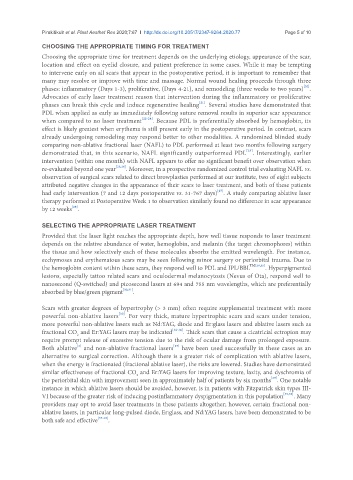Page 791 - Read Online
P. 791
Pirakitikulr et al. Plast Aesthet Res 2020;7:67 I http://dx.doi.org/10.20517/2347-9264.2020.77 Page 5 of 10
CHOOSING THE APPROPRIATE TIMING FOR TREATMENT
Choosing the appropriate time for treatment depends on the underlying etiology, appearance of the scar,
location and effect on eyelid closure, and patient preference in some cases. While it may be tempting
to intervene early on all scars that appear in the postoperative period, it is important to remember that
many may resolve or improve with time and massage. Normal wound healing proceeds through three
[20]
phases: inflammatory (Days 1-3), proliferative, (Days 4-21), and remodeling (three weeks to two years) .
Advocates of early laser treatment reason that intervention during the inflammatory or proliferative
[21]
phases can break this cycle and induce regenerative healing . Several studies have demonstrated that
PDL when applied as early as immediately following suture removal results in superior scar appearance
when compared to no laser treatment [22-24] . Because PDL is preferentially absorbed by hemoglobin, its
effect is likely greatest when erythema is still present early in the postoperative period. In contrast, scars
already undergoing remodeling may respond better to other modalities. A randomized blinded study
comparing non-ablative fractional laser (NAFL) to PDL performed at least two months following surgery
[25]
demonstrated that, in this scenario, NAFL significantly outperformed PDL . Interestingly, earlier
intervention (within one month) with NAFL appears to offer no significant benefit over observation when
re-evaluated beyond one year [23,26] . Moreover, in a prospective randomized control trial evaluating NAFL vs.
observation of surgical scars related to direct browplasties performed at our institute, two of eight subjects
attributed negative changes in the appearance of their scars to laser treatment, and both of these patients
had early intervention (7 and 12 days postoperative vs. 31-767 days) . A study comparing ablative laser
[27]
therapy performed at Postoperative Week 1 to observation similarly found no difference in scar appearance
by 12 weeks .
[28]
SELECTING THE APPROPRIATE LASER TREATMENT
Provided that the laser light reaches the appropriate depth, how well tissue responds to laser treatment
depends on the relative abundance of water, hemoglobin, and melanin (the target chromophores) within
the tissue and how selectively each of these molecules absorbs the emitted wavelength. For instance,
ecchymoses and erythematous scars may be seen following minor surgery or periorbital trauma. Due to
the hemoglobin content within these scars, they respond well to PDL and IPL/BBL TM[29,30] . Hyperpigmented
lesions, especially tattoo related scars and oculodermal melanocytosis (Nevus of Ota), respond well to
nanosecond (Q-switched) and picosecond lasers at 694 and 755 nm wavelengths, which are preferentially
absorbed by blue/green pigment [30,31] .
Scars with greater degrees of hypertrophy (> 3 mm) often require supplemental treatment with more
powerful non-ablative lasers . For very thick, mature hypertrophic scars and scars under tension,
[30]
more powerful non-ablative lasers such as Nd:YAG, diode and Er:glass lasers and ablative lasers such as
fractional CO and Er:YAG lasers may be indicated [32-34] . Thick scars that cause a cicatricial ectropion may
2
require prompt release of excessive tension due to the risk of ocular damage from prolonged exposure.
[2]
Both ablative and non-ablative fractional lasers have been used successfully in these cases as an
[19]
alternative to surgical correction. Although there is a greater risk of complication with ablative lasers,
when the energy is fractionated (fractional ablative laser), the risks are lowered. Studies have demonstrated
similar effectiveness of fractional CO and Er:YAG lasers for improving texture, laxity, and dyschromia of
2
the periorbital skin with improvement seen in approximately half of patients by six months . One notable
[29]
instance in which ablative lasers should be avoided, however, is in patients with Fitzpatrick skin types III-
VI because of the greater risk of inducing postinflammatory dyspigmentation in this population [35,36] . Many
providers may opt to avoid laser treatments in these patients altogether; however, certain fractional non-
ablative lasers, in particular long-pulsed diode, Er:glass, and Nd:YAG lasers, have been demonstrated to be
both safe and effective [37-39] .

